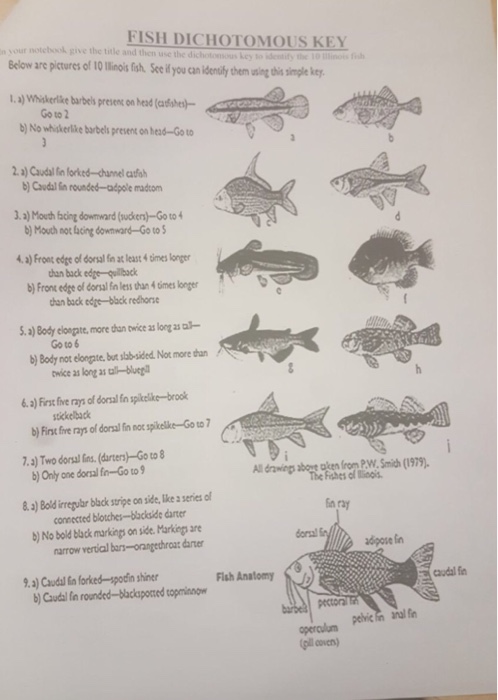What’s that fish? The (dichotomous) key to fish identification
※ Download: Fish dichotomous key answers
By making choices and progressing logically through the key, users follow a path that ends with the correct identification of the organism. This is a dichotomous key. If the teacher detects problem areas, more labs could be created to practice these skills. Molidae ocean sunfishes 25a Adipose fin present 25b No adipose fin.
Head with elevated slope. Moringuidae spagetti eels , Nettastomatidae duckbill eels , Congridae conger eels and Synaphobranchidae cutthroat eels. Other traits, such as fin shape and location, can provide clues about whether a fish is generally a fast swimmer or a slow swimmer. Anal fin with 12 or more rays.

What’s that fish? The (dichotomous) key to fish identification - To correctly identify fish and classify newly discovered species, fisheries scientists use a dichotomous key based on distinguishing characteristics. Dactyloscopidae sand stargazers 66b Mouth not vertical.

Using dichotomous keys, and creating individual dichotomous keys, are learning standards in most middle school science curricula. It teaches students how living things are grouped together by scientists, ultimately leading to their Genus and species name, making up their scientific name. Lesson Objectives: The following New York State Intermediate Science learning standards are addressed in this lesson: S2. Students will learn about how living things are classified, or broken up into groups based on similar characteristics. Students will use their classroom textbooks or some on line tools to practice using dichotomous keys. It usually helps to start with some simple ones, such as classifying shapes triangle, square, rectangle, etc. Some examples of websites featuring dichotomous keys are listed below. This is a completely on-line investigation 3. Assessment: Any of the activities listed above could be used as assessments after several practice runs. Make sure that a complete assessment involves the students creating their own dichotomous key as well as using one that is already done for them. If students do well with the lab, perhaps no further labs would be required. If the teacher detects problem areas, more labs could be created to practice these skills. There are lots of things that can be named or classified to create dichotomous keys for. Students typically enjoy using and creating dichotomous key activities.
By using their knowledge of distinguishing characteristics and a simplified key, students use full-color illustrations of fish to work through the key and make identifications among 10 Great Lakes fish families. fish dichotomous key answers Couplet Characters Goto Pics Other Families not represented 1a Two fleshy dorsal fins with no rays; 5 or more pairs of lateral gill slits; teeth set in set in numerous transverse rows. Torpedinidae electric rays 12a Body laterally compressed with both eyes on the same side flounder-like. This is a completely on-line investigation 3. Lesson Planet has been a tremendous assist to me as a student teacher. Albulidae bonefish 39b Snout approximately even with lower jaw. Acropomatidae temperate ocean bassesAriommatidae driftfishesNomeidae man-of-war fishesIstiophoridae billfishes 86a Chin with 2 distinct pores; area between eye and mouth scaled. Body covered by thick, tough scales or bony plates as in Acipenseridae - sturgeons. No thick, tough scales. Body smooth or prickly. Mouth extends well past the eye. Steindachneriidae luminous hakes 55b Dorsal and anal fins separate from caudal fin 56a Bony longitudinal ridge below eye, sometimes with spines.




